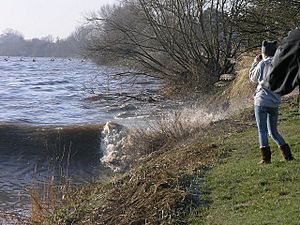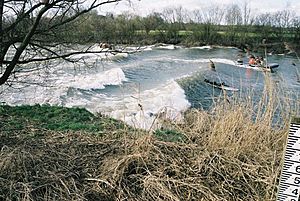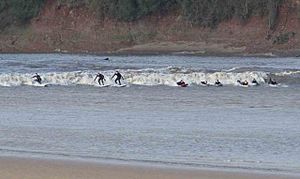Severn bore facts for kids
The Severn bore is a special natural wave that happens on the River Severn in southwest England. It forms when the ocean's tide rushes into the funnel-shaped Bristol Channel and Severn Estuary. This powerful water then pushes its way upstream in a series of waves. It can travel as far as Gloucester and even beyond.
The bore looks different depending on where you are on the river. In wider areas, it might just be a gentle roll in the deep parts, while the water slowly spreads over the sand. But in the narrower parts of the river, the bore becomes a series of noticeable waves that fill the whole river. Near Gloucester, the water even climbs over two small dams called weirs. Sometimes, it can even go over one in Tewkesbury before it finally fades away.
You can see bores on about 130 days each year. They are most common right after the new moon and full moon. How big the bore is and exactly when it arrives depends on things like the time of high tide, the weather, wind, and how much water is flowing down the river. Many people like to watch the bore from special viewing spots or by walking along the riverbanks. Long ago, the bore was important for ships going to Gloucester. But now, a special waterway called the Gloucester and Sharpness Canal helps ships avoid the bore. Today, the bore is mostly exciting for surfers and canoeists who try to ride its waves.
Contents
How the Severn Bore Forms
The Severn Estuary flows into the Bristol Channel. This area has one of the biggest tidal ranges in the world. This means the difference between high tide and low tide is huge, about 13 meters (43 feet)! Only a few other places, like the Bay of Fundy in Canada, have bigger tides.
The giant ocean wave that causes the bore starts far out in the sea. It moves towards Europe. As this wave gets closer to land, the water gets shallower and the space gets narrower. This makes the wave grow taller. When it reaches the Bristol Channel, the width of the water shrinks a lot. The wave's height can reach nearly 15 meters (50 feet)!
As the riverbed rises and the banks get closer, the bore starts to form. It then surges up the river as a strong tidal stream. The front of the wave is steep, while the back is flatter. The bore usually has three or four big waves, followed by smaller ones. Just like other waves, it tends to break in shallow spots and near the banks. But it flows smoothly in deeper water. This wave travels upstream against the river's current at a speed of 13 to 21 kilometers per hour (8 to 13 mph).
In the wider parts of the estuary, the tidal surge looks like a slight roll. The water quickly spreads over the sand and mud. But past Sharpness, the bore really starts to take shape. It crashes into rocks at Hock Cliff, then reforms and travels upriver. As the river narrows near Longney Sands, the bore becomes the amazing sight people expect. From Minsterworth to Gloucester, the bore keeps going strong. Near Gloucester, it splits around Alney Island and goes over weirs. In very high tides, the water can even go over the weir at Tewkesbury.
When to See the Bore
The biggest bores happen around the spring and autumn equinoxes. But you can see smaller ones throughout the year. There are about 260 bores each year, happening twice a day on 130 days. Since bores are linked to the moon's phases, one usually occurs between 7 a.m. and noon. The other happens between 7 p.m. and midnight GMT. The largest bores are typically between 9 and 11 in both the morning and evening. The very biggest bores happen one to three days after a new or full moon.
Timetables that predict the bore's height and timing are published every year. However, these can change a little. A strong wind from the southwest or west, low air pressure, and plenty of fresh water in the river can make the bore taller. Strong winds from the east or north, high air pressure, or less fresh water can make it smaller. The bore can arrive earlier with strong southwest winds and low air pressure. It can be delayed by strong east or north winds and high air pressure.
The bore is the start of the rising tide. So, after it passes, the water level keeps rising for about an hour and a half. The Severn bore is not a single, self-sustaining wave. Instead, it's like a shock wave. It forms because the wave travels faster than the water above it. As the bore passes, it churns the water. The sound of countless tiny bubbles popping makes the loud roaring noise you hear. The tallest bore ever recorded was on October 15, 1966. It reached a height of 2.8 meters (9.2 feet) at Stonebench.
Best Places to Watch
There are several good spots to watch the bore. You don't have to stick to just these places, as many riverbanks are public paths. However, popular viewing spots can get very crowded, and parking might be tricky. The bore passes different places at different times. For example, it reaches Newnham on Severn about an hour before high tide at Sharpness. It reaches Minsterworth at high tide, and Stonebench about 15 minutes after high tide.
One of the main viewing spots is at Minsterworth, near the Severn Bore Inn on the A48. Another good place to see this amazing sight is Over Bridge. However, the view there can be a bit blocked by the nearby railway bridge.
Surfing the Bore
The River Severn used to be an important route for ships going to Gloucester. Ships had to deal with the bore. They could ride the incoming tide from Sharpness to Gloucester. However, getting back downriver was harder. This problem was solved when the Gloucester and Sharpness Canal opened in 1827. This canal allowed ships to bypass the river and reach Gloucester easily.
Today, many river surfing fans try to surf the bore's waves, which can be over 2 meters (7 feet) high! The first person to surf the river was Jack Churchill in 1955. He was a World War II hero known for carrying a Scottish sword and using a longbow in battle. Later in life, he loved surfing and rode the bore on a board he designed.
In September 2005, hundreds of surfers gathered in Newnham on Severn. They celebrated 50 years since the first recorded attempt to surf the Severn bore. They also watched a film called Longwave, which showed how the sport has grown since 1955. In March 2006, Steve King, an engineer from Gloucestershire, set a world record. He surfed the Severn bore for 7.6 miles (12.2 kilometers), earning a Guinness World Record for the longest surfing ride on a river bore.
On days when a big bore is expected, hundreds of surfers gather, waiting for the waves. When the water is high, there can be dangers like floating trees, parts of the riverbank collapsing, or overhanging branches. The Gloucester Harbour Trustees, who manage this part of the river, have given safety tips for surfers, canoeists, and people on the riverbanks.
Images for kids
See also
 In Spanish: Macareo del Severn para niños
In Spanish: Macareo del Severn para niños










